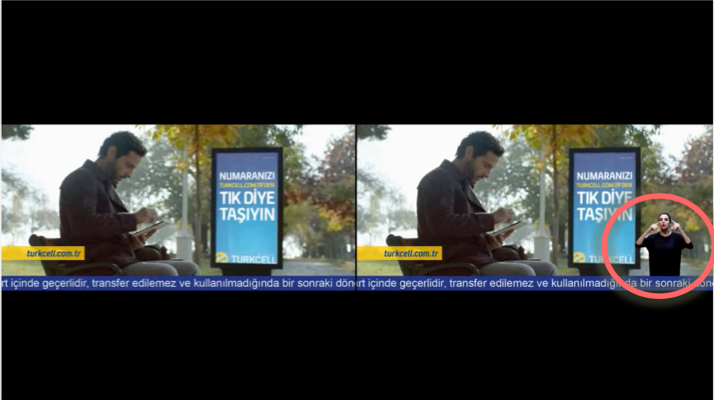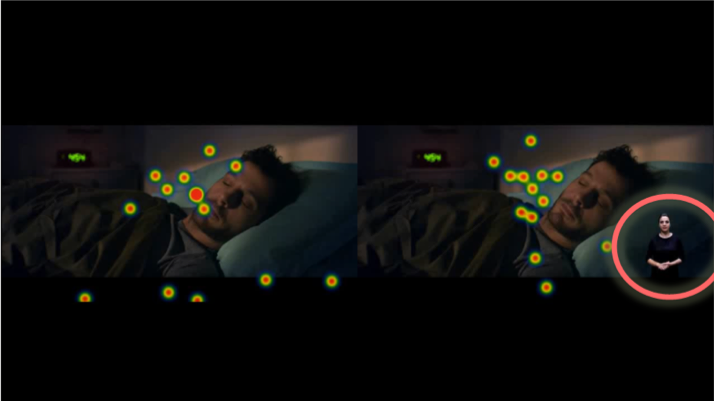Editor’s note: Sili Hacihanefioglu is marketing intelligence lead at Istanbul-based communication and technology services provider Turkcell.
Turkcell is a converged communication and technology services provider in Turkey, active in nine countries with 51.6 million subscribers. Advertising decisions are crucial as Turkcell telecasts hundreds of TV ads each year.
Last year the marketing research team was interested in learning if a narrator on screen during a TV ad would distract the audience and divide their attention, or if it would be an opportunity to become more than a brand – a lovemark. Would having a sign language narrator on the lower-right corner of the screen distract the audience? Could the audience receive the message while watching the narrator’s interesting movements?
We decided to test an ad with sign language to see if the narrator distracts the viewer.

Eye-tracking and EEG
We could have used a conventional technique with face-to-face interviews, asking a few questions about the ads, but from our previous experiences we knew that it is very hard to get the answers explicitly. We needed to go deeper and get detailed insights, so we conducted a hybrid research project consisting of eye-tracking and EEG. We tested two versions of the same ad – one with sign language and one without. We tested both versions on 24 hearing people, followed by 30-minute in-depth interviews. Our sample was composed of both men and women, ages 18-to-45, from various occupation groups.
We used the two techniques simultaneously:
The EEG test tracked brain signals indicating engagement (boring <--> catchy), excitement (calming <--> exciting) and frustration (easy to understand <--> complicated) while watching both versions of the ad.
Meanwhile, with the eye-tracking heat map we measured the point of gaze (where on the screen the audience’s focus is) and tracked the motion of the eyes when watching the ad with the sign-language narrator and without.
The EEG test scores in both cases turned out to be very close to each other, which means the respondents were not distracted or confused by the sign language. Based on the heat map (Figure 2), we observed that respondents did not spend much time looking at the narrator.

Things to consider
Based on this research, the Turkcell team is confident that it is safe to use sign language in our TV ads. To ensure the best viewer experience, the following points should be considered when developing new ads:
- The narrator using the sign language was noticed within the first 1.5 seconds by all the participants. This duration is negligible but we must try not to give an important message during this period of time.
- Respondents focused on the sign language for 0.27 seconds, on average.
- Only 8 percent of overall gazes were on the narrator – which means that the respondents just glanced at the narrator and then continued watching the ad. The narrator did not distract them at all.
- The eye-tracking heat map showed that the audience did not continuously stare at the narrator, just glanced at him from time-to-time.
- The narrator was watched longer during scenes that contrasted with the background. The color difference made the narrator more visible.
- If a scene is complex or includes too much action, the narrator (which is the other element on the screen) increases confusion. Prevent action scenes from overlapping with the narrator.
- When important images/words were used in the lower-right corner of the screen, the viewer’s eyes would shift from the lower right corner and focus on the narrator. Thus, scene design must consider the sign-language narrator during the shooting and editing phases. Some space should be left empty in the right corner.
- The longer the pack shot stays on the screen, the tendency of focusing on the sign-language narrator increases. Try to keep the pack shot short and clear.
It is common practice for advertisements to include subtitles, so it was also important to look at the impact of having a sign-language narrator in addition to subtitles. Almost no time was spent focusing on subtitles in both versions of the ad. Our research shows that the audience spent only 1 percent of the ad time checking subtitles. Therefore, subtitles in these ads did not distract viewers more than they normally do. Only four participants in the sign-language ad spent time on the subtitles, with an average of 0.05 seconds; and six participants did so in the original, with an average distraction time of 0.09 seconds.
Increasing likability
We found out that using sign language in TV ads does not cause viewer distraction or misunderstanding. On the contrary, it increases the likeability of the Turkcell brand and positively effects the brand image attributes.
To make sure that these findings were applicable for all types of ads, we conducted another study with test and control groups for another TV ad and all the results turned out to be the same.
After this study, all Turkcell ads were on air with sign language in 2016. We have observed an increase in brand KPIs in a separate quantitative study that we track quarterly. There was a significant increase in brand image attributes – “best GSM operator,” “brand I love” and “values its customers.” We proved how much we care about our customers and received a lot of positive feedback.
